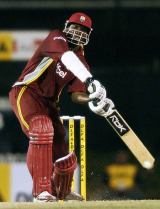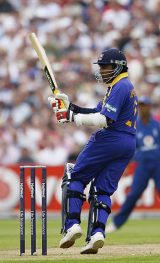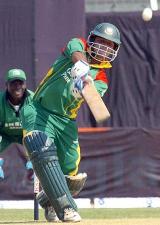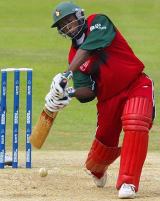Dark horses and settling scores
Cricinfo takes a look at Sri Lanka, West Indies, Zimbabwe and Bangladesh's prospects, and some of the names to look out for
06-Oct-2006
Ten countries have assembled in India to contest the 2006 ICC Champions Trophy. Cricinfo assesses the teams and lists some of the names to look out for. We begin with the four qualifiers:
|
|

|
Brian Lara's third stint as captain has seen a transformation in West Indies' outlook. Home series wins against Zimbabwe and India, when they stopped a rollicking juggernaut on its tracks, set the tone before an impressive performance in the recent DLF Cup in Kuala Lumpur proved that their graph was going upwards. Their Champions Trophy record has veered between extremes - finalists in 1998 and champions in 2004 in contrast to early elimination in 2000 and 2002 - and it comes as no surprise that they start this series, once again, as the dark horses. They boast a batting firepower that can match any, but their penchant for the collapse always leaves them vulnerable, while bowling strengths are built around nagging accuracy. The fielding often toggles between electric and pathetic and, as it's often the case, only one side is capable of causing their undoing, West Indies themselves.
One to watch
He averages 45.35 in the last 15 games, including four fifties and a hundred, hurries through vital overs in the middle stages and pouches catches in the slips. When Chris Gayle strikes, West Indies usually run away with the contest. Unlike earlier, when he used to try to whack every ball into the car park, he's developed a more tempered side now and can endure long periods of lull before breaking away. The two gears in which he bats have confused several teams and very often he's picked up the rate when least expected, and that too at breakneck speed.
New kid on the block
When Lara gushes about a young prospect, you have no option but to take him seriously. Jerome Taylor may not have the intimidating frame of his famed fast-bowling predecessors but he certainly possesses the pace and bounce to hustle top-quality batsmen. A return of 25 wickets in 16 one-day games may not sound great shakes but there is no doubt that he can summon up lethal spells even on dead tracks. Just ask the Indian batsmen, who ran into an energised Taylor on their recent Caribbean tour. His pacy burst on the lifeless surface in St Kitts showed his class and his deadly five-wicket haul at Kingston underlined his worth.
Current form
West Indies will have fond memories of their last tour to India, in 2002, when their rampaging top-order tore through the bowling. Two batsmen stood out: Gayle at the top of the order and Sarwan a little lower down. While Gayle ransacked 455 runs in seven games, including three centuries, Sarwan picked off 436. The fact that Sarwan finished off several games meant that he ended with a sensational average of 109. Both have performed creditably off late and could be the key to West Indies' fortunes in this tournament.
Siddhartha Vaidyanathan
Siddhartha Vaidyanathan
|
|

|
One of the grandest ironies of this ironical tournament is that Sri Lanka will be playing qualifying matches to just find a place in the main draw of Champions Trophy. A terrible showing in India last year cost them a place in the starting eight. While that series proved to be only a blip (they edged South Africa en route to the VB Series finals and they cleaned up England in England), the damage had already been done.
What is interesting is that there is no drastic change in the personnel from their previous Indian tour, a disaster from most angles. Yet, they arrive this time far more upbeat. Their batting has started showing shades of the dangerous line-up of the mid-90s, Chaminda Vaas and Muttiah Muralitharan are still a dangerous combination and their fielding continues to be better than most. The closest they came to a Champions Trophy crown was at home in 2002 - when they shared the trophy with India due to a rain-disrupted final - but they could well upset several calculations in this one.
One to watch
There was a time not long ago when, given the amount of talent, Mahela Jayawardene was considered an under-achiever. But, like it's done to a few others, captaincy changed the man. With Marvan Atapattu was injured, Jayawardene took over a team in tatters and lifted them from the morass. As a captain he averages 49.76, as opposed to his career average of 32.33. The fact that Sri Lanka and Jayawardene have hit a purple patch together is not a coincidence. As a captain, he has won 14 one-day internationals, and lost only four. The pitches in India will be to his liking - he likes to play on the up, loves to hit inside out, and is fantastic against spinners.
New kid on the block
Last last year - with Romesh Kaluwitharana gone, Marvan Atapattu injured, and Sanath Jayasuriya out of form - Sri Lanka's opening woes got compounded. But in England, Jayasuriya solved half the problem and Upul Tharanga put his hand up and completed it. It was Tharanga who starred with a century at Lord's and began Sri Lanka's rampaging run. Tharanga is strong through the covers and backward point but is vulnerable against the short ball. Through the Champions Trophy, Tharanga would like to carry forward the transformation that started in England: from a cautious batsman unsure of his place in international cricket to an attacking one who began resembling his more illustrious team-mates. With Jayasuriya by his side, the pair looks good enough to carry Sri Lanka through to the World Cup.
Current form
The key to winning any tournament in the subcontinent remains the team's batting and a comparison of Sri Lanka's performance on the tour of India in the 2006 season, and their form thereafter gives an indication of their improvement. Jayasuriya, their most important one-day batsman over the years, averaged 14.16 in the dismal series in India; since the start of 2006, he's averaged 79.83. It's similar for the rest of the top order - corresponding numbers for Jayawardene are 27.66 and 72.40; for Tillakaratne Dilshan they're 37 and 53; and for Tharanga they're 17.25 and 62.42.
Sidharth Monga
|
|

|
Bangladesh play Sri Lanka in the first qualifying match ahead of the Champions Trophy with a record of 0-5 in the tournament. They didn't take part in 1998, and were brushed aside by the five teams they've faced since; they've been bowled out for 77, 93, 129 and 131. The three veterans, Khaled Mashud, Mohammad Rafique and Habibul Bashar, are not getting any younger and Mohammad Ashraful continues to baffle more than satisfy. Bangladesh can take heart, however, from the young guns: Shahriar Nafees, a candidate for the ICC's Emerging Player of the Year, Aftab Ahmed, Mashrafe Mortaza, and Shahadat Hossain, all of whom are capable of matchwinning performances.
One to watch
Hands down, Nafees, who is genuinely one of international cricket's top prospects. Appointed vice-captain for the Champions Trophy after just one year at the top, he also recently won Bangladesh's cricketer-of-the-year award. Upon being nominated for the ICC's Emerging Player, award Nafees quickly pointed out that his nomination was not just based on his sublime maiden Test hundred against Australia, "but rather for the whole season where I showed adequate consistency". Nafees has a strike-rate of 66.52 in one-day matches and has scored four half-centuries, three of them away from home. He had a good series against Zimbabwe in July-August this year, averaging 62 in five one-day matches played in Harare.
Hands down, Nafees, who is genuinely one of international cricket's top prospects. Appointed vice-captain for the Champions Trophy after just one year at the top, he also recently won Bangladesh's cricketer-of-the-year award. Upon being nominated for the ICC's Emerging Player, award Nafees quickly pointed out that his nomination was not just based on his sublime maiden Test hundred against Australia, "but rather for the whole season where I showed adequate consistency". Nafees has a strike-rate of 66.52 in one-day matches and has scored four half-centuries, three of them away from home. He had a good series against Zimbabwe in July-August this year, averaging 62 in five one-day matches played in Harare.
New kid on the block
Farhad Reza, a middle-order batsman who bowls useful medium-pace, was called up to the national squad for the tour of Zimbabwe in July 2006 after scoring the most runs in the previous year's domestic league. In his first appearance in national colours he became the only Bangladeshi to hit a fifty on debut. An unbeaten 34 and 41 against Kenya followed - he steered Bangladesh home on both occasions - and backed with his bowling and fielding he looks to be a good prospect.
Farhad Reza, a middle-order batsman who bowls useful medium-pace, was called up to the national squad for the tour of Zimbabwe in July 2006 after scoring the most runs in the previous year's domestic league. In his first appearance in national colours he became the only Bangladeshi to hit a fifty on debut. An unbeaten 34 and 41 against Kenya followed - he steered Bangladesh home on both occasions - and backed with his bowling and fielding he looks to be a good prospect.
Current form
It's been a good enough year for Bangladesh so far, statistically at least, with ten of 18 matches ending in wins. They won a match against Sri Lanka, buried Kenya 4-0 at home, fought well against Australia in a 0-3 loss, fell to Zimbabwe 3-2 and beat Kenya 3-0 again. There have been gritty innings from the youngsters, a record bowling performance (Mortaza, 6 for 26), a hat-trick (Shahadat), and an improved display in the field. If the likes of Nafees, Aftab and Ashraful all come together, Bangladesh have the necessary firepower to push Sri Lanka and West Indies.
Jamie Alter
It's been a good enough year for Bangladesh so far, statistically at least, with ten of 18 matches ending in wins. They won a match against Sri Lanka, buried Kenya 4-0 at home, fought well against Australia in a 0-3 loss, fell to Zimbabwe 3-2 and beat Kenya 3-0 again. There have been gritty innings from the youngsters, a record bowling performance (Mortaza, 6 for 26), a hat-trick (Shahadat), and an improved display in the field. If the likes of Nafees, Aftab and Ashraful all come together, Bangladesh have the necessary firepower to push Sri Lanka and West Indies.
Jamie Alter
|
|

|
Zimbabwe have yet to open their ICC Champions Trophy account, with a total of six matches yielding six losses. They did come close in their very first outing, way back in 1998 when the tournament debuted as the Wills International Cup in Bangladesh, but were nipped to the quarter-finals by New Zealand - rather, Chris Harris, who smashed the last ball for four - in a Dhaka thriller. It was the nearest thing to a win Zimbabwe have seen in the tournament since. The current crop of pace bowlers are inexperienced and the batting order has a tendency to get bogged down when the pressure is turned up the slightest. Prosper Utseya has led the side admirably, but his inexperience in the subcontinent may go against them.
One to watch
There haven't been many positives for Zimbabwe since the exodus of many of their senior players, but a few have shone now and then. Statistically and aesthetically speaking, it's been Vusi Sibanda who has looked good over the last few series, with a maiden hundred, two fifties, and a 46. For a batsman who has been given a long run in the side, he has largely disappointed - as an average of 16.12 from 32 innings before his 116 against Bermuda in in May - but since then he has averaged 33.33. He has looked the best of Zimbabwe's top order batsman against the new ball, and has by and large curbed a front-foot penchant to produce an improved allround game. Zimbabwe will once again look to him for stability up the order.
There haven't been many positives for Zimbabwe since the exodus of many of their senior players, but a few have shone now and then. Statistically and aesthetically speaking, it's been Vusi Sibanda who has looked good over the last few series, with a maiden hundred, two fifties, and a 46. For a batsman who has been given a long run in the side, he has largely disappointed - as an average of 16.12 from 32 innings before his 116 against Bermuda in in May - but since then he has averaged 33.33. He has looked the best of Zimbabwe's top order batsman against the new ball, and has by and large curbed a front-foot penchant to produce an improved allround game. Zimbabwe will once again look to him for stability up the order.
New kid on the block
Chamu Chibhabha lasted just three deliveries on his ODI debut in August 2005, but in the 11 matches that have followed he has looked a good prospect. Two fine half-centuries and a 40 against West Indies, during which he was particularly impressive in playing their quick bowlers, easily made him the success story of the series before he was sidelined with a hamstring injury. On the evidence of those innings and his returns against Bangladesh and South Africa recently, he appears to possess the temperament and the ability to succeed in international cricket and is one of Zimbabwe's brightest prospects.
Chamu Chibhabha lasted just three deliveries on his ODI debut in August 2005, but in the 11 matches that have followed he has looked a good prospect. Two fine half-centuries and a 40 against West Indies, during which he was particularly impressive in playing their quick bowlers, easily made him the success story of the series before he was sidelined with a hamstring injury. On the evidence of those innings and his returns against Bangladesh and South Africa recently, he appears to possess the temperament and the ability to succeed in international cricket and is one of Zimbabwe's brightest prospects.
Current form
Their recent run of form shows Zimbabwe have six wins from 11 matches, but there's a lot to be desired against top-class opposition. Expectedly, they lifted the ICC Tri-Nation series in the West Indies in May, featuring such heavyweights as Bermuda and Canada, followed that up with a 3-2 series win over Bangladesh at home, and were trounced 3-0 when they visited South Africa. That's not including a nine-wicket loss to the Eagles in a Twenty20 warm-up. The series win over Bangladesh was Zimbabwe's 12th since their entry into the international fold in 1983 and their fourth in a bilateral series against that opposition. Zimbabwe outperformed Bangladesh in all departments to win the series with a match to spare, and that did plenty to their confidence. No one expected them to win in South Africa, and the manner in which the bowlers were brought to their knees by Mark Boucher and Co. in the final match was disheartening. The contest effectively ended right there, after South Africa racked up 418 for 5, though to their credit, Zimbabwe batted solidly to complete 50 overs and reach a healthy 247 for 7.
Jamie Alter
Their recent run of form shows Zimbabwe have six wins from 11 matches, but there's a lot to be desired against top-class opposition. Expectedly, they lifted the ICC Tri-Nation series in the West Indies in May, featuring such heavyweights as Bermuda and Canada, followed that up with a 3-2 series win over Bangladesh at home, and were trounced 3-0 when they visited South Africa. That's not including a nine-wicket loss to the Eagles in a Twenty20 warm-up. The series win over Bangladesh was Zimbabwe's 12th since their entry into the international fold in 1983 and their fourth in a bilateral series against that opposition. Zimbabwe outperformed Bangladesh in all departments to win the series with a match to spare, and that did plenty to their confidence. No one expected them to win in South Africa, and the manner in which the bowlers were brought to their knees by Mark Boucher and Co. in the final match was disheartening. The contest effectively ended right there, after South Africa racked up 418 for 5, though to their credit, Zimbabwe batted solidly to complete 50 overs and reach a healthy 247 for 7.
Jamie Alter